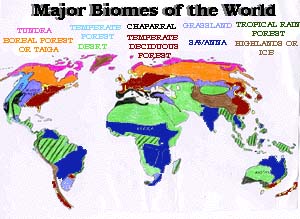Environmental
Science
Biomes Study
| Your task
in this activity is to create a very user friendly, presentation about
biomes.
Your overall goal is to create something that will be educational, fun,
and easy to use. The project will teach about the major biomes found
around our world and offer solutions to the problems that these biomes
face. The project should represent biomes through artistic as well
as scientific methods.
The major biomes of the world are: Tundra,
Grassland, Marine, Taiga, Temperate Forest, Tropical Rainforest, Savanna,
and Desert. |

Map by Anna C. |
Essential Question:
How are healthy biomes important to a healthy Earth?
Focus questions: (Answer these questions for
the biome that you are researching.)
What:
Where on the Earth is your biome found?
What kind of a climate is necessary for the biome?
What is an ecostystem?
List at least two biotic and two abiotic elements found
in your biome.
So What: (Pick two)
What dangers does the biome face? (Include human impact)
What kind of a food web might you find in your biome?
What kind of tropic pyramid would you find in your biome?
Now What: (Pick one)
What solutions or preventative measures can be found
to any dangers that threaten the biome?
What are the characteristics of an environmentally healthy
Earth?
How does your biome help maintain the health of the
Earth?
Research links:
What
is an Ecosystem - Just what it says!!
Biome
Basics: Learn about biomes through this online guide. Find profiles
of desert, grassland, ocean, rainforest,
tundra, temperate forest and taiga biomes.
Report
on Biomes and Ecosystems written for Congress.
Descriptions
of ecoregions of the US
Welcome
to the World's Biomes Page. This is an introduction to the major biomes
on Earth. From students in the Biome Group of the Fall '96 Biology Class
at UC Berkley.
Explore the
forests, deserts, tundra, taiga and grasslands of North America. Provided
by Professor Reveal of the University of Maryland.
The Evergreen Project
displays an intensive study of the Earth's biomes through the eyes of the
Roads Scholars, a group of students who travelled across the country studying
biomes.
Biome
classification and descriptions.
Earth
Biomes Explorer - Guide to the world's ecosystems include specifics
on Arctic, forest, desert, taiga, and tropical
climates. Learn how to read a climograph.
Biomes
and weather - a description of how biomes are formed based on global
wind patterns.
Find the climate in any city
in the world
Enchanted Learning
Guide
to the Earth's habitats includes details about the animals living in each.
Charts compare
different ecosystems.
Major
Biomes of the World Scan a beginner's guide to biomes, the major
regional groupings of plants and animals discernible
at a global scale. Find maps and photos.
Mysterious Journey Survey
descriptions and photos of rain forest, grassland and desert biomes.
Rainforest Alliance
- Site dedicated to preserving the rainforest.
Explore
the Fantastic Forest with National Geographic.
Wetlands from the
National WIldllife Federation.
The Rainforest report
card.
Environmental Health
Environmental
report card from 1994
Earth's Environmental
Report Card put out by World Watch Magazine.
A Guide to Global
Issues
Report
telling how forests help global warming.
Extinction
of species around the world.
The
extinction of species.
Sounds
Misc.
sound effects. Includes nature sounds.
An assortment of animal sounds
from Naturesongs.com
Even more nature sounds
(wav)
